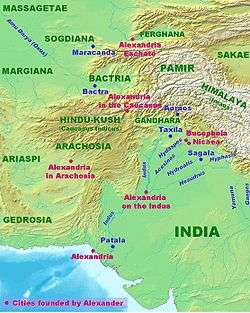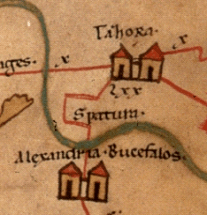Alexandria Bucephalous
| Alexandria Bucephalous | |
|---|---|
| City | |
 Alexandria Bucephalous, or Bucephala (center right), was located on the Hydaspes river, north of nearby Nicaea across the river. | |
| Country | Pakistan |
Alexandria Bucephalous (also variously known as Alexandria Bucephalus, Alexandria Bucephala, Bucephala, or Bucephalia), was a city founded by Alexander the Great in memory of his beloved horse Bucephalus.[1][2] Founded in May 326 BC, the town was located on the Hydaspes (Jhelum River), east of the Indus River.[2] Bucephalus had died after the Battle of the Hydaspes in 326 BC. The garrison was settled with Greek and Iranian veterans and Pauravas locals.[2] It had large dockyards, suggesting it was intended as a center of commerce.
Alexandria Bucephalous remained a significant centre for some time, as it is mentioned in the Metz Epitome and shown on the late Roman Peutinger Table map.
The 1st-century Periplus of the Erythraean Sea reads:
The country inland of Barigaza is inhabited by numerous tribes, such as the Arattii, the Arachosii, the Gandaraei and the people of Poclais, in which is Bucephalus Alexandria.
Around 17 cities were named with the pre-name "Alexandria" during the period. Across the river, the nearby town of Alexandria Nicaea was also founded on the battle site at that time.[2][4] Alexander founded nearly 20 towns,[2] but also renamed others for a total of about 70 towns reportedly (Pliny) named by him.[2]
Location
The exact site of the city is still unknown but several locations have been proposed:
- G.W.B. Huntingford identifies this Alexandria with a large mound west of Jhelum, a city 150 miles (242 km) south east of Peshawar, Pakistan.,[2] while Lendering cites Jhelum more generally.
- The Hungarian archaeologist and Silk Road expert Sir Marc Aurel Stein believed that instead of the road from Taxila to Jhelum which dates from medieval times, Alexander's army went south to cross the river near modern Bhera. At this site the battle would have happened near the modern town of Mong. The topography, river orientation and natural features including salt cliffs in this vicinity match closely the description in ancient sources.
- Further supporting this location is the claim by the residents of Mong and nearby Phalia that their towns are Nicaea and Bucephala.
 Bucefala in the 4th century as shown on the Peutinger Map.
Bucefala in the 4th century as shown on the Peutinger Map.
- The historian and BBC presenter Michael Wood supports Stein's claims for Nicaea at Mong, but proposes Garjak rather than Phalia for the location of Bucephala. Phalia is significantly distant at 17km and located east of the River when ancient sources agree it was on the west bank opposite Nicaea. Furthermore, archaeological finds at Garjak include Greek coins and ruins of an ancient Hindu temple with a burial stone in the shape of a horse. There is also a legend associated with Garjak regarding a magical horse.
- Another less likely proposed site is near modern Jalalpur south of these sites where there are extensive but still un-excavated ruins. Tarn profits this site, which is not to be confused with the Jalalpur nearby on the Chenab river, which was a city of Alexander's contemporary Chandragupta Maurya. Eggermont disagrees with the Jalalpur identification arguing that the Jhelum river flowed far from this site in ancient times.
- Local historian Mansoor Behzad Butt of Gujrat District supports the idea Bucephalus was buried in Jalalpur Sharif.
- P. M. Fraser, a supporter of a Jhelum site concludes that "only archeological excavation will settle the century old debate".
See also
Notes
- ↑ "The History of Alexander the Great", Pseudo-Callisthenes, Ernest Alfred Wallis, 1889, p.161 (see below: References).
- 1 2 3 4 5 6 7 "Alexander the Great: his towns", Jona Lendering, Livius.org, 2007 (see below: References): states "Nicaea and Bucephala: twin foundation of permanent garrisons on opposite banks" of Hydaspes (Jhelum river), "founded in May 326 on the battle field"; plus "Settled with Greek & Iranian veterans & natives" and might be "modern Jhelum" in Pakistan; towns had "large dockyards" suggesting they were centers of commerce.
- ↑ Periplus of the Erythraean Sea, Fordham.edu, webpage: Fordham-edu-periplus
- ↑ Ian Worthington. Alexander the Great: a reader. Illustrated edition, reprint Publisher Routledge, 2003, ISBN 0415291860, ISBN 978-0-415-29186-6. p. 175
References
- Eggermont P.H.L., Alexander's campaign in Southern Punjab (1993).
- Fraser P M Cities of Alexander the Great (1996)
- Jona Lendering, "Alexander the Great: his towns", Livius.org, 2007, webpage: Livius-alex-z2.
- Pseudo-Callisthenes, Ernest Alfred Wallis, The History of Alexander the Great, 1889, page 161, Google Books link: books-google-18.
- Michael Wood, In the Footsteps of Alexander The Great A Journey from Greece to Asia, 1997, University of California Press ISBN 978-0-520-23192-4 Google Books link:
Coordinates: 32°55′52″N 73°43′51″E / 32.93111°N 73.73083°E